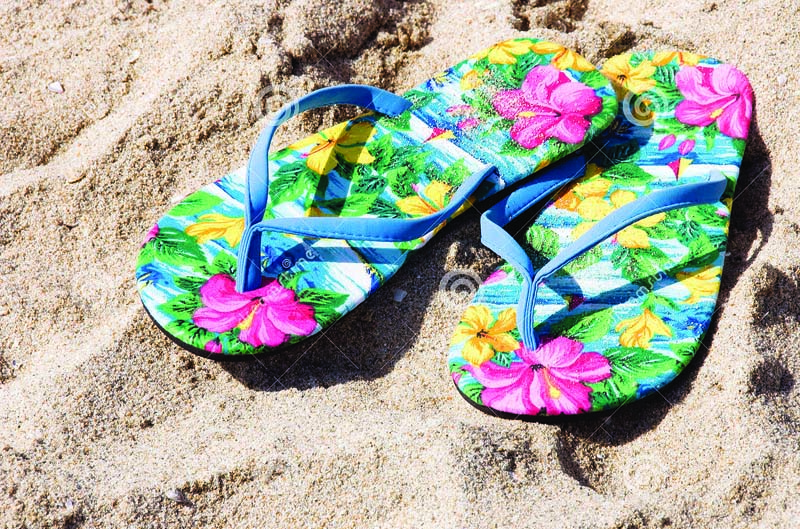
Flip-flops must not bend in half
With very fragile, or flimsy flip-flops, you barely have more support than if you were barefoot. Lack of support can cause inflammation of the plantar fascia, a thick band of tissue that runs from the ball of your foot to the heel, resulting in arch pain. Over time, this may even cause foot flattening. “The arch helps you absorb stress as you walk,” says Ken Jung, a foot and ankle surgeon at Kerlan-Jobe Orthopaedic Clinic in Los Angeles. “If flip-flops or sandals are not providing adequate arch support, your foot will fatigue faster. You’ll feel sore as you rely on tendons that help support the arch.” Bend your flip-flops in half; if they’re flexible and fold, they aren’t providing enough support.
Moisturising is especially important
Did you know your chappals expose your feet to dirt and bacteria, and the cracks in your dry skin can, in turn, harbour grime? “If somebody’s feet are very dry and they have cracked skin, especially on the bottom of the foot, they are more prone to infection because debris can get into the cracks of the skin,” shares Steven K Neufeld, MD, director of the Orthopaedic Foot & Ankle Centre Division at the Centres for Advanced Orthopaedics. “Make sure the feet are well-moisturised and that there are no cracks in the skin.” If you’re not the ‘lotion sort’, grab your nearest petroleum jelly jar and slather on for notable results.
Pay attention to the rest of your body
Your flip-flops or sandals may be causing you more than just foot pain. “If somebody’s foot pronates, in which the arch collapses, it could put strain on other parts of the body,” says Dr Neufeld. “If you wear flip-flops without support, it could cause strain and pain in the knees, hip, and lower back.” One Auburn University study found that participants who wore flip-flops took particularly short steps. This can throw your natural gait and body posture off-kilter, also leading to pain in your knees, ankles, hips, and back. Ouch!
Use these tricks to break ‘chappals’ in
Breaking in new shoes is undeniably uncomfortable. If you wear thong sandals, you must consider extra padding. “Lay a bandage between the first and second toes to give yourself a little more cushion,” says Dr Jung. “You can also try breaking in the sandal yourself by using your fingers. Just stretch the material so it’s not as rigid.” Wear new flip-flops in short increments of time to avoid blisters and calluses. For instance, your next Nathia Gali trip is not the time to sport your new sandals — or any, without good support, for that matter.
Wear them for relaxation only
Sandals are not meant for walking through the mall. “Remember, flip-flops are really reserved for poolside and beach,” reveals Jacqueline Sutera, a podiatrist and spokesperson for the American Podiatric Medical Association and Vionic Innovation Lab. “That is what the shoes are made for. They’re meant to protect you from sand and water.” Sandals and flip-flops also increase your chances of tripping and injury. “Sandals provide no support to keep the foot in place, so it’s very easy to trip, twist or sprain your ankle, or even break a bone,” says Dr Neufeld. Now, that information shattered a lot of our hearts!
4 tips to make your scent last longer
Have diabetes? Be extra cautious
People with diabetes or certain neurological diseases sometimes have difficulty feeling sensation in their feet. This means they can’t always feel when items are lodged between their feet and the sandals — a hazardous situation other shoes can better prevent. “I’ve seen many, many people who come into my office and have a rock lodged into their foot and they don’t even feel it,” says Dr Neufeld. Sometimes lack of sensation can also result in blisters, cuts and bruises from the straps of the shoes rubbing the top of the foot. “If somebody doesn’t have normal feeling in their feet, it’s important that they check their feet multiple times a day,” notes Dr Neufeld.
Know when it’s time for new flip-flops
Even if your sandals were once supportive, they may grow flimsy after years of wear. “They might still look cute from the top, but you really have to inspect the bottom,” says Dr Sutera. “The soles can tell you a lot about whether or not the shoe is in good shape. Worn-out soles will be tilted.” Don’t stress though, and try this at-home test to check for yourself: place the shoes on a table top and look at them at eye-level. If they’re not completely flat, it’s time to get them repaired or replace them.
Published in The Express Tribune, March 25th, 2016.
Like Life & Style on Facebook, follow @ETLifeandStyle on Twitter for the latest in fashion, gossip and entertainment.











1723024092-0/BeFunky-collage]___-(8)1723024092-0-270x192.webp)






COMMENTS
Comments are moderated and generally will be posted if they are on-topic and not abusive.
For more information, please see our Comments FAQ